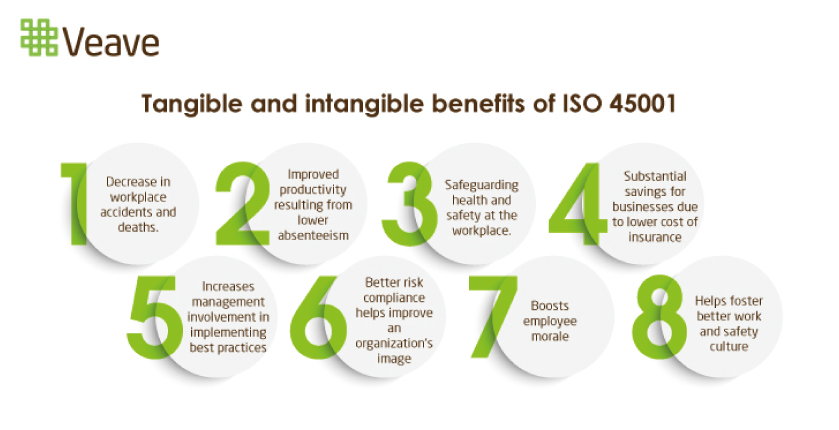-
INDIA
-
-
OMAN
+968 9638 5351 -
QATAR
+974 7745 6815 -
BAHRAIN
+973 37450939 - Request Quote
How does ISO 45001 Standard Implementation tackle Occupational Hazards in Workplaces?
Whether one is a Business Owner, Manager, or employee, everyone shares a common goal, and that is no one should get hurt while on the job. But unfortunately, despite the precautions organizations take, mishaps do happen.
As per the International Labor Organization (ILO), around 340 million non-fatal occupational accidents occur every year, and 160 million workers are victims of work-related illnesses. Another 2.30 million men and women workers die of work-related accidents, which means 6000 deaths every day. ILO updates these estimates at regular intervals. These accidents, unfortunately, cause an enormous burden on society and organizations.
Despite these accidents, businesses need to manage their risks to survive and grow. The ISO, which has defined standards in other areas, developed the ISO 45001 dedicated explicitly to occupational health and safety. These standards help reduce operational risks at workplaces and create better working conditions globally.
ISO 45001 Certification - modern international standards for Occupational Health and Safety (OHS)
These new management system standards are well-designed to become a part of the business irrespective of whether any organization implements it or not. Organizations are adopting this standard to minimize the losses due to cost burden in the event of accidental deaths to their employees, early retirement and absenteeism, and an increase in insurance premiums. By adopting this standard, an organization can create a reference framework for better working conditions protocol.
The ISO 45001 designed towards occupational health and safety has a definitive structure like other standards, such as 9001 and 14001. It also considers and accommodates different international standards specific to this domain, such as OHSAS 18001, the guidelines of ILO.

Advantages of ISO 45001
Tangible and intangible benefits that arise out of the implementation of this standard includes the following:
Impact of ISO 45001 on external influences
The ISO 45001 not only impacts an organization's internal process, but requires them to consider how their suppliers outsourced third-party vendors to manage their risks. It is significant when many organizations outsource their business process to external service providers.
The overall framework of ISO 45001 in the context of OHSAS
Organizations that have been using OHSAS 18001 delegate the health and safety responsibility to a Safety Officer. The ISO 45001 integrates the health and safety protocols into the organization's central management system. It helps management to take a more proactive role in this area.
The ISO 45001 standards do not conflict with ILO-OHSAS guidelines but help to integrate the OHS process in the overall business operational process. They use a consensus approach that benefits businesses to align with formal management protocols adopted for other business risks in the basket of ISO standards. By aligning seamlessly, they help SME's who struggle to manage multiple standards compliances.
While other standards like ISO 9001 and ISO 14001 require a formal transition from existing ISO standards, this is not the case with ISO 45001. Instead, smooth integration of OHSAS 18001 is necessitated with ISO 45001.
Certain fundamental concepts are modified, such as risk, workers, and workplace in ISO 45001. Also, new terminology like surveillance, performance, efficiency, measures, and OH&S process are included. The ISO 45001 stipulates that documented information must be maintained to the maximum extent possible to ensure that the processes are executed as per plan.
How is ISO 45001 different from OHSAS?
ISO 45001 emphasizes identifying and managing risks rather than identifying hazards required by OHSAS 18001 earlier. They follow a process that is preventive and which evaluates hazard risks and corrects them rather than managing the hazards as followed by OHSAS. This approach is proactive rather than being reactive. By adopting ISO 45001 standards, organizations identify the potential risks beforehand and prevent accidents, injuries and deaths. This standard is subject to audits, analysis of work-related safety procedures, and monitoring of working conditions.
How to start ISO 45001 Certification Process?
An organization considering implementing the ISO 45001 can follow this procedure to get started:
Hiring a consultant for the implementation of ISO standards in the management system
Organizations need to get in touch with reputed ISO 45001 consultants to carry out the implementation. These ISO 45001 Consultants have the expertise in implementing ISO standards. They are also domain experts in many industries. They can be a great asset in understanding the risks existing in the organization before implementing ISO 45001 standards. Right from suggesting the changes in the existing infrastructure to costs and time frame required for implementation, an ISO 45001 Consulting Services can offer end-to-end solutions.
Final takeaway
To implement ISO 45001 it is significant to examine the existing management system already in place. Organizations following other ISO standards like the 9001 and 14001 find it easier to implement and integrate ISO 45001.
To sum up, ISO 45001 is a critical standard that is a must for all organizations, especially the manufacturing sector, where the health and safety of employees are non-negotiable.
Request a Call Back